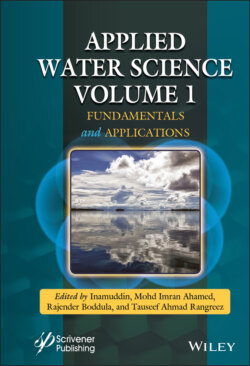Читать книгу Applied Water Science - Группа авторов - Страница 31
2.3.4.1 Conventional Removal Methods
ОглавлениеPharmaceuticals in drinking water are linked to their presence in raw water (Wang et al., 2019). The conventional drinking water treatment train has unit operations which include coagulation/flocculation, clarification, filtration, and disinfection (Zhang et al., 2017). These may be further complemented by advanced methods like activated carbon, membrane filtration, ozonation, or advanced oxidation processes. The conventional drinking water treatment process is incapable of efficiently removing pharmaceutical compounds from source water (Cunha et al., 2019). Nonetheless, limited removals could occur during the disinfection stage, which commonly uses chlorine, chlorine dioxide, and ozone (Patel et al., 2019; Wu et al., 2019). During clarification, chemicals are added to the source water to destabilize and flocculate colloidal particles, and facilitate settling together with suspended solids and sediments. For instance, ferric chloride causes hydrolysis of hydrophilic pharmaceutical compounds such as acetaminophen, dehydronifedipine and sulfamethoxazole, resulting in their removal, albeit at low percentage. The effectiveness of coagulation/flocculation is pH and dosage dependent (Ramavandi, 2014). Solution pH affects the availability of OCl- and HOCl, and this consequently affects the oxidation process. The disinfection stage has been reported to remove up to 75% of acetaminophen, erythromycin, and sulfamethoxazole (Patel et al., 2019). Chlorine dioxide oxidizes and removes pharmaceutical compounds more effectively than chlorine. Nonetheless, some pharmaceuticals are significantly reduced by ozone. Despite its capacity to degrade a variety of pharmaceutical compounds, chlorination is limited to aqueous systems which are less polluted to avoid elevated concentrations of ammonia and dissolved organic carbon. Moreover, the mineralization due to chlorination is insignificant, and it potentially produces a variety of disinfection byproducts, which are carcinogenic to humans (Zhang et al., 2017; Tian et al., 2019).
Most wastewater treatment plants use primary screening, aerobic and anaerobic digestion, and biological filtration processes. Although these plants are not designed to remove pharmaceuticals, they can moderately remediate them. Many pharmaceutical compounds cannot effectively adsorb onto activated sludge, and microbes used in secondary treatment cannot completely digest them (Patel et al., 2019). In addition, xenobiotics inhibit microbial activity, hence their incomplete removal (Tsoumachidou et al., 2017). The variations in the removal of pharmaceutical compounds are influenced by the chemical structure, design of the treatment process, and the physico-chemical characteristics of the source water, which is a function of seasonal variation. The hydrophobicity of the pharmaceuticals influences their removal. For instance, while polar compounds have very low removals (7%–10%), pharmaceuticals with medium polarity exhibit higher removals (Patel et al., 2019). Thus, the treatment method, plant design, residence time, seasonal variation, and operating conditions influence the degradation of pharmaceuticals in wastewater treatment plants. Whereas biodegradation mainly occurs when the pharmaceutical compounds are in solution, the adsorption process involves electrostatic attractions and/or hydrophobicity, and the content of suspended matter (Rosales et al., 2017; Patel et al., 2019). At neutral pH, acidic pharmaceutical compounds ionize to the conjugate base decreasing the adsorption on sludge. However, basic and zwitterionic pharmaceutical compounds exhibit significant adsorption. Generally, the degradation of pharmaceutical compounds increases with increasing residence time. Compared to pharmaceuticals with short and linear side chains, long and branched pharmaceuticals are less susceptible to biodegradation (Patel et al., 2019). Aromatic and saturated aliphatic pharmaceuticals with sulfur and halogen moieties are also recalcitrant to biodegradation. The degradation of some pharmaceutical compounds significantly increases with the age of the sludge. Partitioning of the pharmaceuticals between the aqueous phase and sludge is influenced by the hydrophobicity of the compound; whereby highly hydrophobic pharmaceutical compounds are attracted, particularly to biosolids with a high concentration of organics (Wang et al., 2018).
Traditionally, biological methods have been used in the management of pharmaceutical effluent. Pharmaceutical compounds and their metabolites undergo both aerobic and anaerobic decomposition in wastewater treatment processes (Hou et al., 2019; Patel et al., 2019). For instance, microbial cultures can be used to degrade pharmaceutical compounds. Environmental biodegradation is particularly important for the degradation of pharmaceutical compounds, especially when wastewater treatment plants are ineffective (Patel et al., 2019). Microorganisms can biotransform pharmaceutical compounds through metabolic biodegradation or via co-metabolic processes with other compounds. Because certain strains of algae, bacteria, and fungus biodegrade pharmaceutical compounds, biodegradation can be achieved using algal, bacterial, and fungal cultures.
